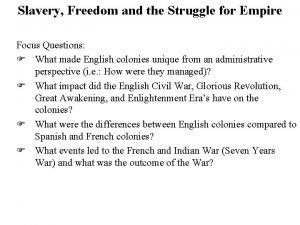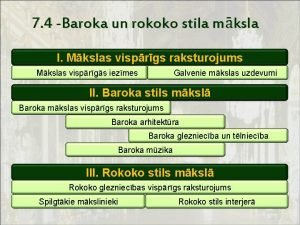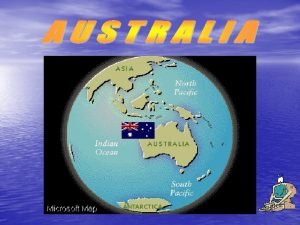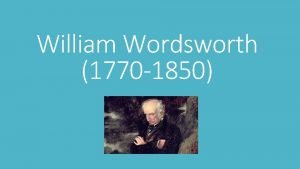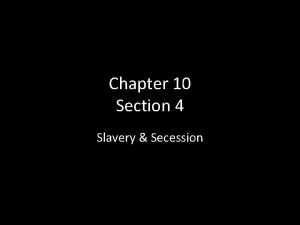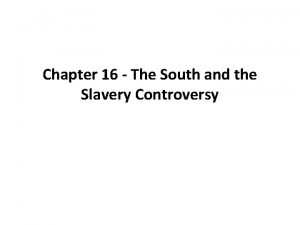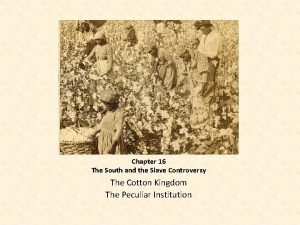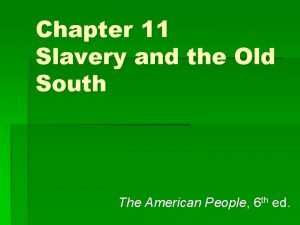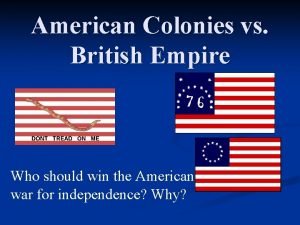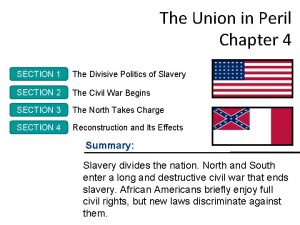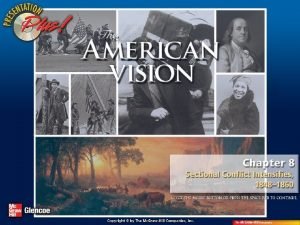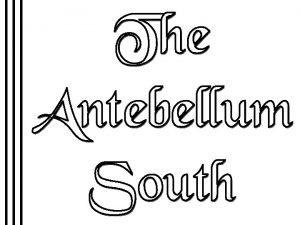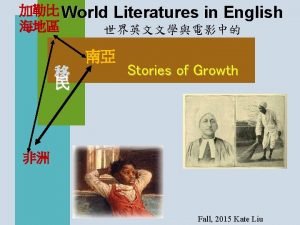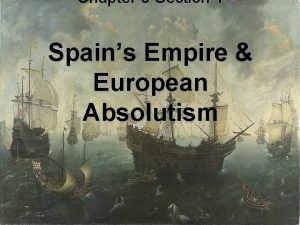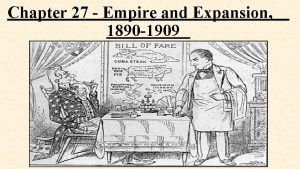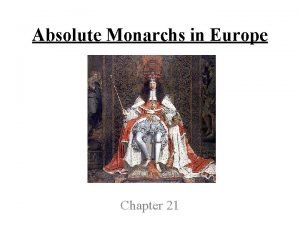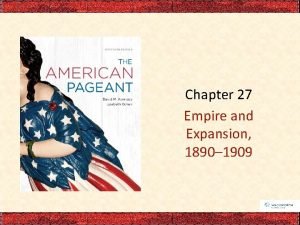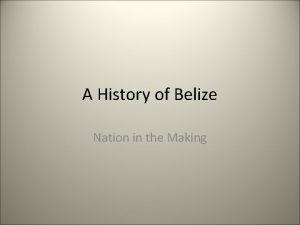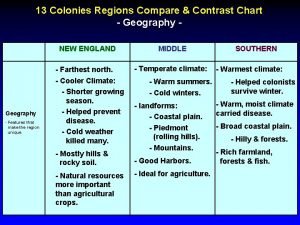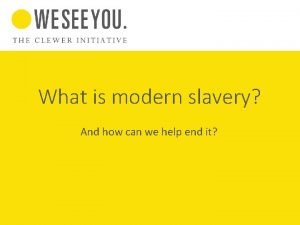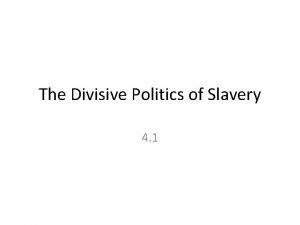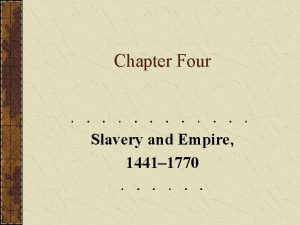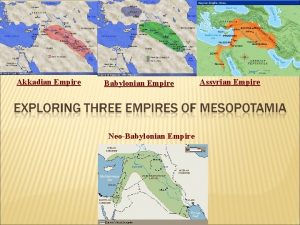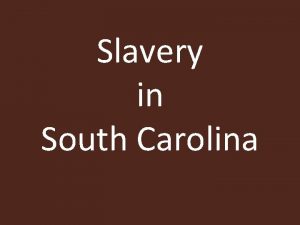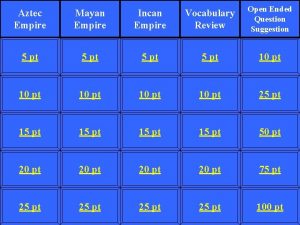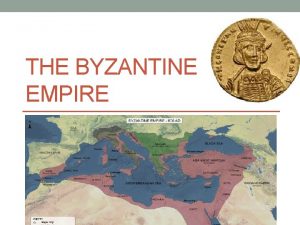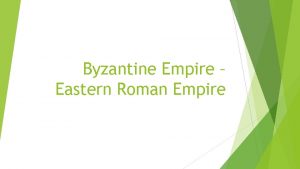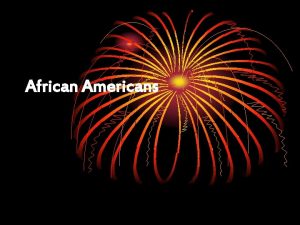Chapter Four Slavery and Empire 1441 1770 Slavery








































- Slides: 40

Chapter Four Slavery and Empire, 1441– 1770

Slavery and Empire, 1441– 1770 What does this painting tell us about African slavery?

Chapter Focus Questions How did the slave system develop? What was the history of the slave trade and the Middle Passage? How did communities develop among African Americans in the eighteenth century? What connections existed between the institutions of slavery and the imperial system of the eighteenth century? What was the early history of racism in America?

The Beginnings of African Slavery Sugar and Slavery Europeans were concerned with the moral implications of enslaving Christians. Muslims and Africans could be used as slaves because they were not Christians. In 1441, the Portuguese opened the trade by bringing slaves to the sugar plantations on the island of Madeira. The expansion of sugar production in the Caribbean increased the demand for slaves.

West Africans Slaves came from well-established societies and local communities of West Africa. More than 100 groups lived along the West African coast. Most important institution was the local community organized by kinship. Most West African societies were based on sophisticated systems of farming and metalworking. Extensive trade networks existed. Household slavery was an established institution. Slaves were treated more as family than as possessions. In W. Africa, children of slaves were born free. Markets for slaves were already established before Europeans utilized them for transatlantic slavery.

The African Slave Trade The Demography of the Slave Trade Most slaves were transported to the Caribbean or South America. One in twenty were delivered to North America (600, 000) The movement of Africans across the Atlantic was the largest forced migration in history. Between 10 and 11 million African slaves came to the New World. Map: The African Slave Trade Table: Estimated number of African Imported to British North America, 1701 -1775 Table: Africans as a Percentage of the Total Population of the British Colonies, 1650 -1770

MAP 4. 1 The African Slave Trade The enslaved men, women, and children transported to the Americas came from West Africa, the majority from the lower Niger River (called the Slave Coast) and the region of the Congo and Angola.

FIGURE 4. 1 Estimated Number of Africans Imported to British North America, 1701– 75 These official British statistics include only slaves imported legally, and consequently undercount the total number who arrived on American shores. But the trend over time is clear. With the exception of the 1750 s, when the British colonies were engulfed by the Seven Years War, the slave trade continued to rise in importance in the decades before the Revolution. SOURCE: R. C. Simmons, The American Colonies: From Settlement to Independence (London: Longman, 1976), 186.

FIGURE 4. 2 Africans as a Percentage of Total Population of the British Colonies, 1650 – 1770 Although the proportion of Africans and African Americans was never as high in the South as in the Caribbean, the ethnic structure of the South diverged radically from that of the North during the eighteenth century. SOURCE: Robert W. Fogel and Stanley L. Engerman, Time on the Cross (Boston: Little, Brown, 1974), 21.

Slavers of All Nations The slave trade was dominated by the Portuguese in the sixteenth century, the Dutch in the sugar boom of the seventeenth century, and the English who entered the trade in the seventeenth century. New England slavers entered the trade in the eighteenth century. Arrangements were generally made with local African headmen and chiefs to conduct raids to capture potential slaves.

The Shock of Enslavement was an unparalleled shock. African raiders or armies often violently attacked villages to take captives. The captives were marched in coffles to the coast, many dying along the way. On the coast, the slaves were kept in barracoons where they were separated from their families, branded, and dehumanized.

The Middle Passage The Atlantic voyage was called the Middle Passage because it was the middle portion of the triangle trade. Slaves were crammed into ships and packed into shelves 6 feet long and 30 inches high. There was little or no sanitation and food was poor. Dysentery and disease were prevalent. Slaves resisted by jumping overboard, refusing to eat, and revolting. One in six slaves died during this voyage.

Arrival in the New World The sale of human cargo occurred in several ways. A single buyer may have purchased the whole cargo. Individual slaves could be auctioned to the highest bidder. The “scramble” had the slaves driven into a corral and the price was fixed. • Buyers rushed among the slaves, grabbing the ones they wanted. In the sale process, Africans were closely examined, probed and poked.

Olaudah Equiano In 1756, Olaudah Equiano was eleven years old and living with his family in what is now Nigeria. He was captured by African slave raiders and transported to America. Purchased first by a Virginia tobacco planter and later by an English sea captain, Equiano served as a slave for ten years before buying his freedom. He published his autobiography in 1789 as part of his dedication to the antislavery cause.

Olaudah Equiano “The closeness of the place, and the heat of the climate, added to the number in the ship, which was so crowded that each had scarcely room to turn himself, almost suffocated us. This produced copious perspirations, so that the air soon became unfit for respiration, from a variety of loathsome smells, and brought on a sickness among the slaves, of which many died, thus falling victims to the improvident avarice, as I may call it, of their purchasers. This wretched situation was again aggravated by the galling of the chains, now become insupportable; and the filth of the necessary tubs, into which the children often fell, and were almost suffocated. The shrieks of the women, and the groans of the dying, rendered the whole a scene of horror almost inconceivable. ” Olaudah Equiano, The Middle Passage (1788)

The Development of North American Slave Societies

Slavery in North America Slavery spread throughout the Caribbean and southern coast of North America. By 1770, Africans and African Americans numbered 460, 000 in British North America -- comprising over 20% of the colonial population. Map: Slave Colonies of the seventeenth and eighteenth Centuries (Next page)

MAP 4. 2 Slave Colonies of the Seventeenth and Eighteenth Centuries By the eighteenth century, the system of slavery had created societies with large African populations throughout the Caribbean and along the southern coast of North America.

Slavery Comes to North America Between about 1675 and 1700 the Chesapeake went from being a society with slaves to a slave society. There was a decline in immigration of English servants. European immigrants had better opportunities in other colonies. Expansion of slavery prompted Virginia to develop a comprehensive slave code. More Africans were imported into North America between 1700 and 1710 than in the entire previous century.

The Tobacco Colonies Tobacco was the most important commodity produced in eighteenth century North America, accounting for 25 % of the value of all colonial exports. Slavery allowed the expansion of tobacco production since it was labor-intensive. The slave population in this region grew largely by natural increase.

The Lower South Carolina was a slave society from its founding. Rice and indigo were the two major crops. In South Carolina, large plantations employing many slaves dominated. Georgia prohibited slavery until South Carolina planters began to settle on the coast with their slaves. Indigo from the indigo plant Cotton Plantation

Slavery in the Spanish Colonies Though the papacy denounced slavery it was a basic part of the Spanish colonial labor system. The character of Spanish slavery varied by region. In Cuba, on sugar plantations, slavery was brutal. In Florida, slavery resembled household slavery common in Mediterranean and African communities. In New Mexico, Indian slaves were used in mines, as house servants, and as fieldworkers. Spain declared Florida a haven for runaway slaves from the British colonies and offered land to those who would help defend the Spanish.

Slavery in the North Slavery was a labor system in some northern commercial farming areas but only made up ten percent of the rural population in these regions. In port cities, slavery was common. By 1750, the slave and free African populations made up 15 to 20 % of the residents of Boston, New York, and Philadelphia. Elsewhere in the countryside, slavery was relatively uncommon. Antislavery sentiment first arose among the Quakers of New Jersey and Pennsylvania.

African to African American

The Daily Lives of Slaves Africans formed the majority of the labor force that made the plantations profitable and thus built the South. As agricultural peoples, Africans were used to rural routines and most slaves worked in the fields. On small plantations and farms, Africans may have worked along side their masters. Large plantations provided the population necessary for the development of an African American culture.

Families and Communities In the development of African American community and culture, the family was the most important institution but it could be fractured. Slave codes did not legalize slave marriages and families were often separated by sale or bequest. Slaves created family structures developing marriage customs, naming practices, and a system of kinship. Fictive kinship was used by slaves to humanize the world of slavery.

African American Culture The formative period of African American community development was the eighteenth century. The resiliency of slaves was shown in the development of a spiritually sustaining African American culture drawing upon dance, music, religion, and oral tradition. Until the Great Awakening, large numbers of African Americans were not converted to Christianity. The invention/development of an African American language facilitated communication between Americanborn and African slaves.

The Africanization of the South Residence and Slave Quarters of Mulberry Plantation Acculturation occurred in two directions--English influenced Africans and Africans influenced English. Africanization was evident in: cooking: barbecue, fried chicken, black-eyed peas, and collard greens material culture: basket weaving, wood carving, and architecture language: yam, banjo, tote, buddy music and dance: banjo

Violence and Resistance The slave system was based on force and violence. Africans resisted in the following ways: Refusing to cooperate and malingering Mistreating tools and animals Running away Revolt There was always fear of uprisings but slaves in North America rarely revolted. Conditions for a successful revolt were not present. Slaves had also developed culture and communities and did not want to risk losing these things.

Slavery the Mainspring Map: Triangular Trade across the Atlantic The slave trade was the foundation of the British economy. Created a large colonial market for exports that stimulated manufacturing Generated huge profits that served as a source of investments Supplied raw cotton to fuel British industrialization Table: Value of Colonial Exports by region, annual average, 1768 -1772

MAP 4. 1 The African Slave Trade The enslaved men, women, and children transported to the Americas came from West Africa, the majority from the lower Niger River (called the Slave Coast) and the region of the Congo and Angola

Value of Colonial Exports by Region, Annual Average, 1768– 72 With tobacco, rice, grain, and indigo, the Chesapeake and Lower South accounted for nearly two-thirds of colonial exports in the late eighteenth century. The Middle Colonies, however, were also becoming major exporters of grain. SOURCE: James F. Shepherd and Gary M. Walton, Shipping, Maritime Trade and the Economic Development of Colonial America (Cambridge: Cambridge University Press, 1972), 211 – 27.

A penny for your thoughts There were 12 Pennies in a Shilling and 20 Shillings in a Pound (£). One Shilling GBP in 1760 had the purchasing power of about £ 6. 54 GBP today. As of today £ 6. 54 = $10. 76 How much was a pound worth back then in today’s currency? Multiply $10. 76 by 20 and you see that one pound in the late 1700 s was worth $215. 20 today. Am I right?

The Politics of Mercantilism: What does that mean Mr. Nothstine? Colonies existed to benefit the mother country The economy should be controlled by the state If you are a mercantilist you believe the economy is a “zero-sum game” where profits for one country meant losses for another. This is actually false, extremely false. Competition between states was to hoard the fixed amount of wealth that existed in the world.

What is wrong with the idea of Mercantilism? Mother Country Is wealth a limited commodity? Can improving Raw Material another person’s ability to gain wealth help you to become more wealthy? Manufactured Goods Currency Colony

British Colonial Regulation European nations created state trading monopolies to manage the commerce of its empires. The Navigation Acts passed between 1651 and 1696 created the legal and institutional structure of Britain's colonial system. The Wool, Hat, and Iron acts reduced colonial competition with British manufacturing interests. Great Britain did not allow colonial tariffs, banking, or local coinage. The increase in colonial trade led Britain to pursue a policy of "salutory neglect. "

The Colonial Economy The colonial economy grew rapidly. The New England shipbuilding was stimulated by trade. Benefits for northern port cities Participation in the slave trade to the South and West Indies Trading foodstuffs for sugar in foreign colonies Between the 1730 s and 1770 s, the commercial economies of the North and South were becoming integrated.

White Skin Privilege Skin color determined status. Legal and other racial distinctions were constant reminders of the freedom of white colonists and the debasement of all African Americans, free or slave. Relationships between free whites and enslaved blacks produced a mixed-ancestry group known as mulattoes. Majority of mulattoes were slaves. Racism created contempt between African Americans and colonists.

A very good question What attitudes did whites have in slave-owning America? This is a complex question, identify the different positions.

American Slavery If you are interested in reading more about this topic, find American Slavery 1619 -1877 by Peter Kolchin. Mr. Nothstine thinks it is the best book out there on the subject.
 Madonna met kanselier rolin
Madonna met kanselier rolin Slavery freedom and the struggle for empire
Slavery freedom and the struggle for empire 1770-1827
1770-1827 1770-1827
1770-1827 Fragonārs
Fragonārs Who discovered australia in 1770
Who discovered australia in 1770 Padre beethoven
Padre beethoven Born in bonn germany
Born in bonn germany Did you notice something
Did you notice something Hegel 1770 a 1831
Hegel 1770 a 1831 Wordsworth was born in
Wordsworth was born in Mauryan empire and gupta empire venn diagram
Mauryan empire and gupta empire venn diagram Chapter 10 section 4 slavery and secession
Chapter 10 section 4 slavery and secession Chapter 16 the south and the slavery controversy
Chapter 16 the south and the slavery controversy Chapter 16 the south and the slavery controversy
Chapter 16 the south and the slavery controversy Chapter 11 cotton slavery and the old south
Chapter 11 cotton slavery and the old south Chapter 11 cotton slavery and the old south
Chapter 11 cotton slavery and the old south American empire vs british empire
American empire vs british empire Byzantine empire vs roman empire venn diagram
Byzantine empire vs roman empire venn diagram Toward civil war lesson 3 secession and war
Toward civil war lesson 3 secession and war Chapter 4 section 1 the divisive politics of slavery
Chapter 4 section 1 the divisive politics of slavery 4 straight sides
4 straight sides Lesson 1 slavery and western expansion
Lesson 1 slavery and western expansion Key and peele slavery
Key and peele slavery Racism and slavery
Racism and slavery Chapter 5 section 1 spain's empire and european absolutism
Chapter 5 section 1 spain's empire and european absolutism Lesson 2 the arab empire and the caliphates
Lesson 2 the arab empire and the caliphates Chapter 5 section 1 spain's empire and european absolutism
Chapter 5 section 1 spain's empire and european absolutism Algeciras conference apush
Algeciras conference apush Emerging europe and the byzantine empire
Emerging europe and the byzantine empire Spain's empire and european absolutism chapter 21 section 1
Spain's empire and european absolutism chapter 21 section 1 Chapter 27 empire and expansion
Chapter 27 empire and expansion 4 eyes in 4 hours
4 eyes in 4 hours Aspects of negro life: from slavery through reconstruction
Aspects of negro life: from slavery through reconstruction Apush chapter 2 american experiments notes
Apush chapter 2 american experiments notes Slavery in belize
Slavery in belize Comparing and contrasting the thirteen colonies
Comparing and contrasting the thirteen colonies What was the first new england colony
What was the first new england colony Net reproduction rate
Net reproduction rate Rooney family slavery
Rooney family slavery The divisive politics of slavery
The divisive politics of slavery

